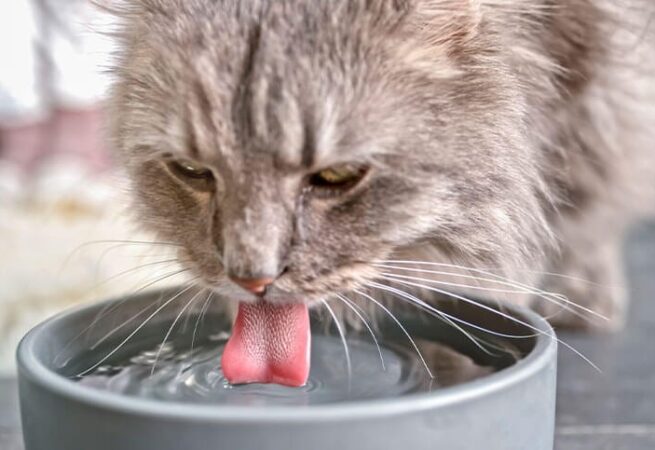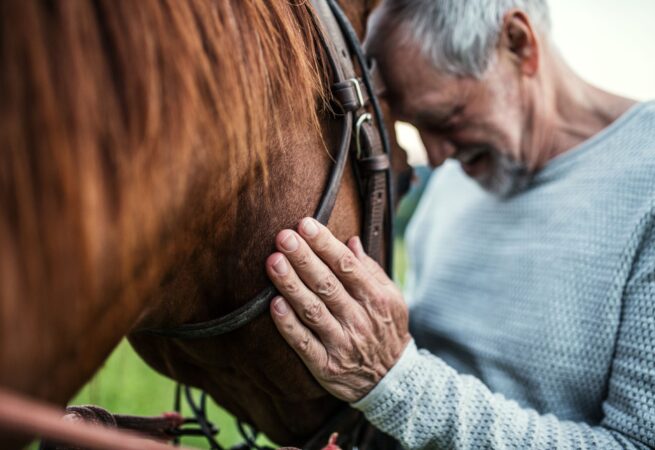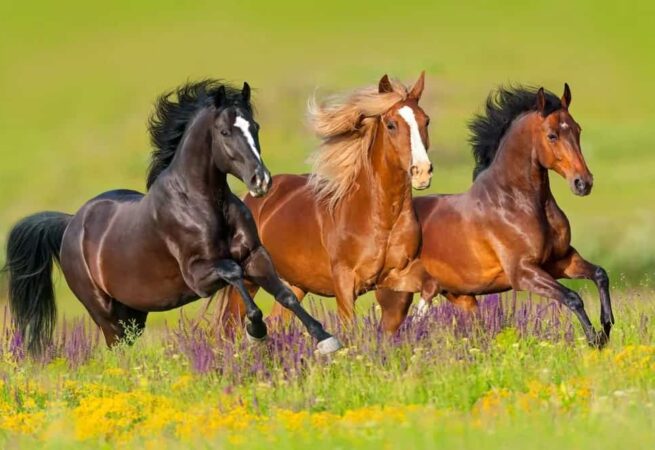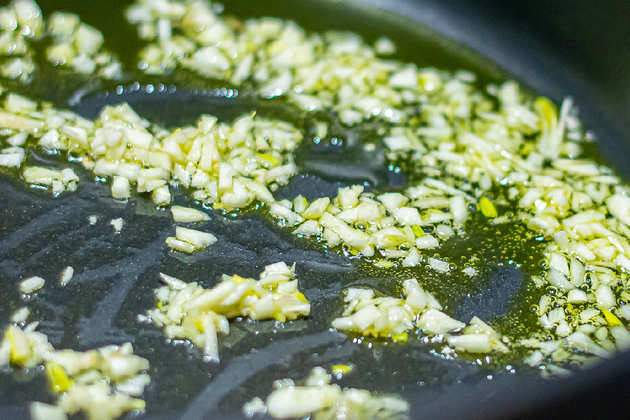

Discover Costa Blanca in Spain
Why Costa Blanca – The White Coast – with its breathtaking beaches is still a hot spot for holidaymakers.

Revered as the ‘White Coast’ for its breathtaking beaches, Costa Blanca stands as one of Spain’s most sought-after destinations.
Encompassing an impressive 124 miles (200 kilometres) of Mediterranean coastline in the Alicante province, on the southeastern coast of Spain and basking in over 300 days of annual sunshine, this picturesque paradise reigns supreme in the realm of vacations.
Prepare to be captivated not only by its sun-drenched shores but also by the myriad of other attractions that await.
Start your journey through Costa Blanca
Are you yearning to embark on an exhilarating adventure? We knew you would be. The time has come to immerse yourself in the enchanting world of Costa Blanca.
ALICANTE Alicante seamlessly marries cultural allure with radiant, golden sunbeams – not to mention its awe-inspiring coastline. A visit to this stylish city is an absolute must. Place Santa Bárbara Castle, serene parks, artisan boutiques, and trendy bars at the forefront of your itinerary for an unforgettable experience.

Parque Natural Serra Gelada. Albir
ALBIR Albir, a coastal haven with a distinct edge, beckons sun enthusiasts in search of relaxation in an upscale locale. Drop by for a traditional tapas feast during lunchtime or indulge in a leisurely stroll to El Faro lighthouse, where spectacular views and a refreshing stretch await as your reward.
ALTEA Enchanting Altea, situated north of Alicante, continues to exude the same timeless charm it boasted back in the 1950s when it first introduced itself on the tourist map. Meander through its charming cobbled streets, explore the historic quarter and delightful promenade, and ensure you carve out time to explore the bustling local market and cycling routes.
CALPE For history enthusiasts who prefer a leisurely pace, the former fishing village of Calpe beckons. Boasting an impressive 14 beaches, it seamlessly blends contemporary high-rises with cherished Spanish architecture, all complemented by a natural park, marina, and salt mine.
Unravelling the finest beach escapes
LEVANTE BEACH BENIDORM – Benidorm’s prestigious Levante Beach, awarded the Blue Flag status, offers an array of thrilling water sports, vibrant bars, and delectable restaurants. Take a moment to recline on a sunbed and admire the immaculate sand, which is consistently well-maintained. It’s a haven for beach aficionados!

Playa Poniente
PONIENTE BEACH, BENIDORM The gently swaying Blue Flag on Poniente Beach positions it front and centre as one of Benidorm’s top-rated beaches. Relish in over 3 km of pristine, well-preserved sands, complete with sun loungers at your disposal and an array of eateries to ensure you’re nourished and refreshed. Pure bliss.
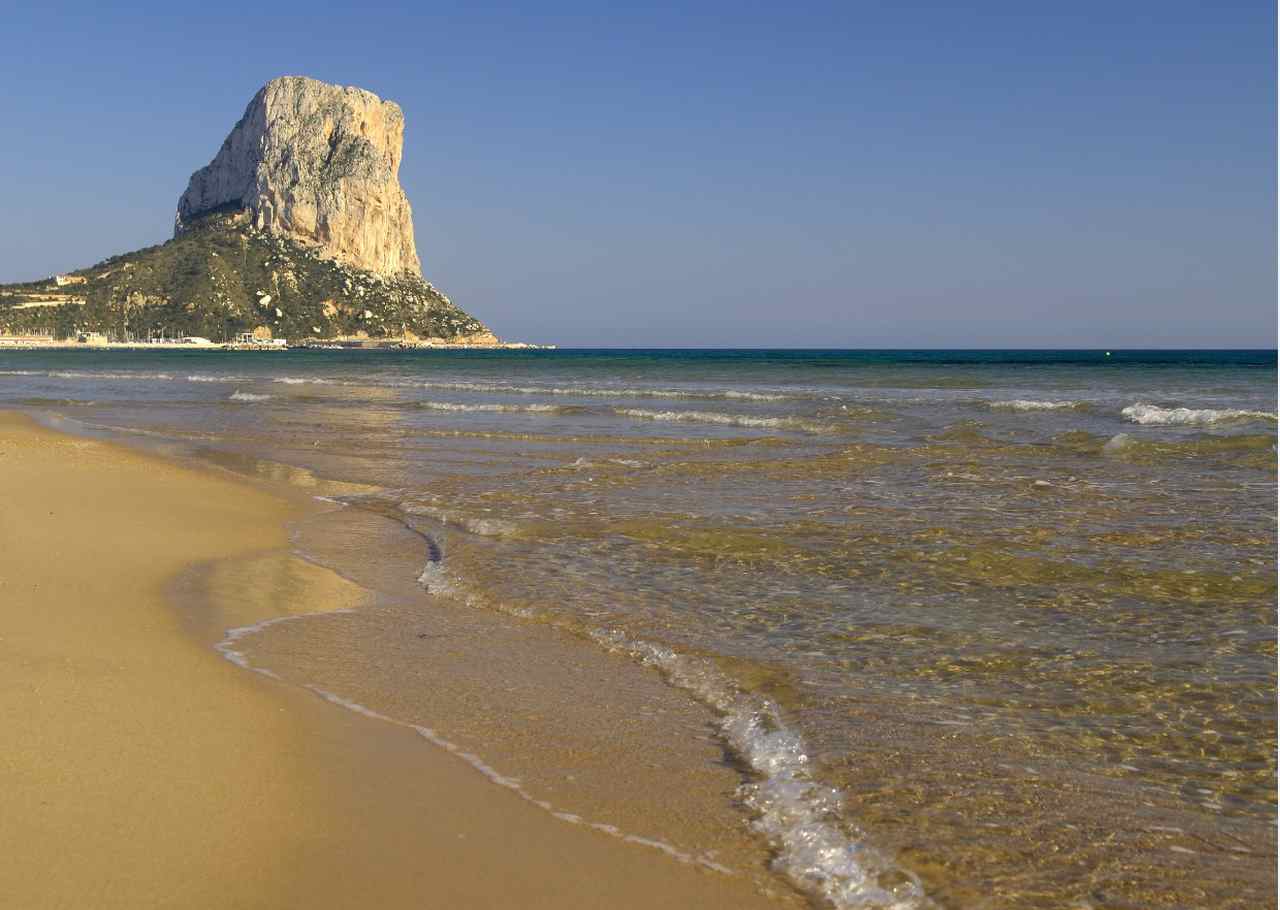
Playa Arenal-Bol, Calpe
PLAYA ARENAL-BOL, CALPE Among Calpe’s impressive selection of 14 beaches, Playa Arenal-Bol stands out as a sunbathing haven. With over a kilometre of sandy expanse, choose your ideal spot to relax and unwind. Numerous bars and restaurants are also conveniently situated nearby.
PLAYA DEL ALBIR, ALBIR If the glistening white sands and crystal-clear waters of this sun-soaked spot weren’t enough to entice you, its coveted Blue Flag status might just do the trick. Nestled between Benidorm and Altea, it offers an idyllic haven for relaxation and soaking up the abundant sunshine.
Must do activities for all ages
FOR ADULTS… Whether you’re an aficionado of water sports or prefer the solid ground beneath your feet, Costa Blanca has an array of options to enchant you.

Villaitana golf
Stay active with a round of golf – after all, what’s better than honing your swing while soaking up the sun’s rays? Las Rejas Open Club is a leisurely option for pitch and putt, while the 18-hole Villaitana Golf invites you to master trick shots over bunkers.
From invigorating road biking to picturesque coastal cycling routes, you’ll thrive in the open expanses of Costa Blanca.
Cycling enthusiasts extol the virtues of the region’s loops, so go ahead – give them a whirl. And if history, scenery, or photography tickles your fancy, Parque Natural de Penyal D’Ifach is your haven.
FOR THE FAMILIES… For families, excitement knows no bounds in this region – particularly at Aqua Natura, where thrilling rides and splash-happy slides ensure non-stop fun. Adrenaline junkies with older kids will relish Aqualandia, with its Vertigo and Black Hole attractions. If you’re seeking a tamer experience, the Wave Pool awaits.
Perhaps you’re drawn to hair-raising rides set against the backdrop of ancient Egypt, Rome, and Greece?
Feast your eyes on the exhilarating Terra Mitica. The whole family will be captivated by Mundomar, a park where encounters with birds, reptiles, and even dolphins await. Nature enthusiasts will be astounded by the beauty of the Algar Waterfalls.
When it comes to embracing the wonders of Costa Blanca and its neighbouring attractions, there truly is something for everyone – from sun-soaked relaxation to exhilarating adventures and family-friendly escapades.
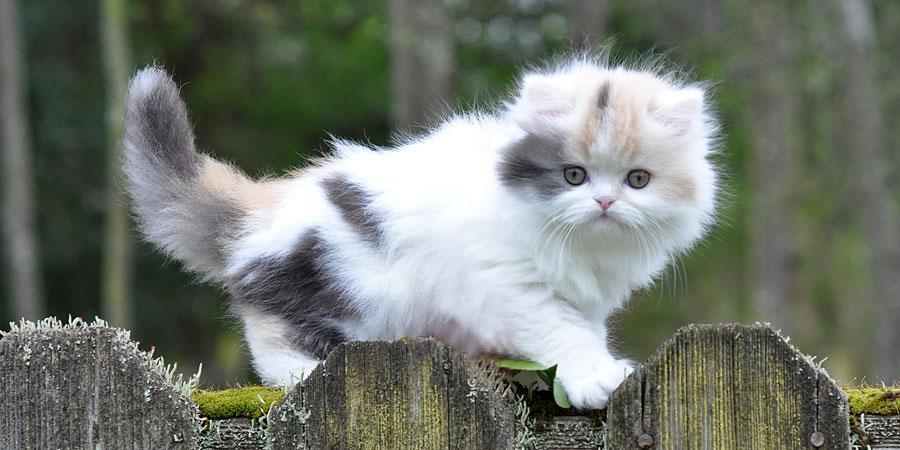
Dwarfism In Cats
Some cats are naturally smaller than others, but unlike this natural variation in size, feline dwarfism is often associated with numerous health issues.
Dwarfism in cats is the result of a genetic disorder, and there are a few cat breeds in which this genetic disorder is selectively bred, such as the Munchkin.
What is dwarfism in cats?
Dwarfism in cats is caused by rare genetic defects which lead to the development of disproportionate and undersized mature adult cats. There are three main types of dwarfism in cats – osteochondrodysplasia, pituitary dwarfism and selective dwarfism.
Osteochondrodysplasia is a developmental abnormality of the bone and cartilage, which results in a lack of normal bone growth. Achondroplasia is one form of osteochondrodysplasia. Affected cats may have a full-size body, but disproportionately short and thick legs and a large head.
Pituitary dwarfism is caused by a deficiency of growth hormones produced by the pituitary gland. Affected cats will be slow to develop and have stunted growth.
Some breeders selectively breed for genetic abnormalities that result in dwarfism, with the Munchkin breed being the result of this selective breeding. This is a controversial topic because these cats are predisposed to a number of health issues.
You may have heard of the terms miniature or teacup cat. These cats are sometimes incorrectly classified as dwarf cats. However, miniatures and teacups, though undersized, are still cats of normal feline proportions.
Signs of dwarfism in cats
Dwarfism in cats results in a number of symptoms, which vary depending on the underlying cause. They may include:
- Larger than normal head
- Undershot jaw with a shorter nose
- Abnormal bone shape
- Poor growth or lack of growth
- Bones appear shorter than normal
- Enlarged joints
- Sideways bowing of forelimbs
- Spinal deviation to either side of the body
Do Munchkin cats have dwarfism?
The Munchkin cat is often cited to be the original dwarf cat breed and is characterised by its very short legs. The Munchkin cat does not have all the traits seen in some cats with dwarfism, so the condition observed in the Munchkin is sometimes referred to as pseudo achondroplasia.
How to diagnose dwarfism in cats
To start the process of diagnosing your cat with dwarfism, you’ll need to provide your veterinarian with a detailed medical history, including when you first noticed symptoms of growth abnormality and any information you have about your cat’s genetic background. Routine checks such as blood tests and urine samples will rule out other causes for the disorder.
X-rays of the affected limbs may be taken, which will show any abnormalities related to bone growth and structure. To confirm the diagnosis, your veterinarian may take samples of tissue to send off for further testing.
How to treat dwarfism in cats
After a diagnosis, your veterinarian may decide to correct some of the impact of feline dwarfism with surgery. However, the results of a corrective surgery do not always result in positive outcomes. Pain relievers and anti-inflammatory medications are recommended for many affected cats as bone deformities can cause pain in movement as well as secondary problems like arthritis. However, some cats with dwarfism go on to live relatively comfortable and healthy lives.
How to care for a cat with dwarfism
Feline dwarfism is a very complex and often poorly understood aspect of feline health and care. The prognosis of this condition depends on the extent of the problem. There is no definitive treatment option available for treating cats with dwarfism, and the outcome varies according to the severity of the disorder and which bones are affected. For some cats, bone dysplasia can be debilitating, whereas, for others, they can learn to compensate for the smaller limb size and reduction in mobility.
One of the possible issues to keep in mind is the increased risk of cat obesity, a common side effect of this disorder. Make sure that your cat sticks to a healthy feline diet and that you are observant of its weight and physical health. As dwarf cats have a high risk of bone and joint issues, it is sometimes advised that they are kept as indoor cats. This gives even more reason to make sure they are on a healthy diet to ensure that they stay slim. Keeping them mentally stimulated is also important to reduce the risk of boredom and behavioural problems.
Due to this being a condition of the bones, the chance of developing cat arthritis is higher as your cat ages. If your veterinarian does recommend pain medications, be sure to follow your veterinarian’s advice and stick to the instructions.
Each cat has their own set of unique traits, which is what makes them endearing and special family members. Dwarf cats and kittens may appear even cuter than most, with their short legs and unique physique. However, cat owners need to be aware of the negative impact selective breeding may have had on the health and mobility of dwarf cats. They must also be prepared for the consequences of these traits and the treatments that come with them.

How Long Do Dogs Really Live
We all love our furry friends but can’t help but wonder how much time we actually have with them.
We’ve put together an article to answer the question ‘how long do dogs live?’ and help you cherish your pooch for years to come. Find out all you need to know below!
How long do dogs live?
On average, dogs live for 10-13 years which is roughly equivalent to 60-74 human years, although there is no hard and fast way of working this out. When thinking about ‘how long do dogs live?’, it’s important to note that elements like lifestyle, food and breed can affect a dog’s life span. Some dogs have even lived into their 20s!
If you’re wondering how long specific breeds live, we have information on that below:

How long do Chihuahuas live?
Chihuahuas reportedly live for, on average, 7.91 years. However, average life spans are only partly useful and the Chihuahua is a good example of this. One study showed that quite a lot of Chihuahuas will die at a young age.
This pulls down the average life expectancy. However, it also means Chihuahuas that have reached six years old will likely live a lot longer than eight.
How long do Pugs live?
Pugs are said to have an average lifespan of 7.65 years. They are brachycephalic, which means that their skull is shorter, and their face is flattened. You’ve probably heard that like many brachycephalic breeds, pugs are, unfortunately, predisposed to many health conditions, which means that their lifespan is shorter than some other breeds.

How long do Shih Tzus live?
Shih Tzus are known for their longevity and live, on average, for 11.05 years. Despite their longer life expectancy, they are more likely to have eye diseases, like dry eye and cataracts.
They can also develop conditions like arthritis and hypothyroidism, which affects organ function and metabolism. This is something to look out for in your Shih Tzu, and call a vet if necessary.
How long do German Shepherds live?
German Shepherds are said to live for an average of 10.16 years. Female German Shepherds reportedly live 1.4 years longer, on average, than males! Unfortunately, large dogs like German Shepherds, are prone to developing dog arthritis which results in decreased mobility. With big dogs, a greater mass means more stress on joints, so be sure to keep your pet at a healthy weight. Bear this in mind with German Shepherds and remember to consult a vet with any concerns.
More average lifespans of dog breeds
- Jack Russell Terrier: 12.72 years
- English Bulldog: 7.39 years
- French Bulldog: 4.53 years
- Yorkshire Terrier: 12.54 years
- Border Collie: 12.10 years
- Springer Spaniel: 11.92 years
- Labrador Retriever: 11.77 years
- Staffordshire Bull Terrier: 11.33 years
- Cocker Spaniel: 11.31 years
- Miniature poodle: 14.2 years

Which dog breed has the longest life expectancy in the UK?
According to the Royal Veterinary College, Jack Russell Terriers have the longest dog life expectancy in the UK.
The same researchers also found that, on average, female dogs live 4 months longer than male dogs.
From the PDSA, vet Claire Roberts has said that the smallest breeds survive the longest (7-14 years) and large dogs the shortest (5-13years).
How to increase your dog’s life expectancy
We’ve answered ‘how long do dogs live?’ but now you’re probably wondering ‘how can I increase my dog’s life expectancy?’ As we mentioned previously, keeping your dog healthy is key to having a robust, and potentially longer, life. This means:
- Regular exercise and mental enrichment
- A good, balanced diet
- Lots (and lots) of love
- Good dental care
- Regular vet visits

Matar Mushroom Masala Recipe
If you love mushrooms then you must try this recipe. Matar mushroom is the most basic curry that is prepared in Indian Cuisine. If you want to taste the awesomeness of this dish, prepare it at home with white button mushrooms and an amalgamation of spices along with green peas. It is a sufficient lunch and dinner recipe. Matar mushroom masala can be easily prepared for a scrumptious meal. It can also be made for special occasions like birthday, anniversary, game night and kitty party. Make it at home and enjoy it with your friends and family.

Ingredients of Matar Mushroom Masala
- 200 gm mushroom
- 3 medium tomato
- 1 green chilli
- 1 teaspoon coriander powder
- 2/3 teaspoon garlic paste
- 3 tablespoon refined oil
- 2/3 cup frozen peas
- 1 medium onion
- 1/2 teaspoon red chilli powder
- 2/3 teaspoon ginger paste
- water as required
- salt as required
How to make Matar Mushroom Masala
Step 1 Saute onions and spicesHeat oil in a pan or kadhai and add the finely chopped onions and saute till translucent. Add ginger-garlic paste and saute till the raw smell disappears. Then, add the chopped tomatoes and green chillies. Stir well and add turmeric, red chilli, and coriander powder.Stir well and saute till oil separates from onion-tomato masala mixture.
Step 2 Add mushrooms and peas, and cook well
Add the chopped mushrooms and peas. Stir well and saute for 2 to 3 mins. Then, add water and salt as required. Mushrooms will leave water so add accordingly. In case there is too much water even after the peas or mushrooms are cooked, then reduce the water by simmering the matar mushroom curry without a lid for some more minutes till you get the desired consistency. Cover the pan and cook till the peas are softened. Then, sprinkle garam masala powder. Mix well and serve matar mushroom masala hot with roti or paratha.

Roasted Vegetables Recipe
Yearning for a quick meal, which is not just satiating but has a perfect mix of taste and health, then we have got you covered! This simple yet exotic recipe is perfect for every palate. Perfectly roasted veggies with a mélange of spices and herbs, can not only boost your nutritional quotient, but at the same time take your indulgence to a different level.

Ingredients of Roasted Vegetables
- 2 yellow bell pepper
- 2 zucchini
- 2 medium tomato
- 5 sprigs rosemary leaves
- 1 teaspoon mixed herbs
- 1 teaspoon paprika
- salt as required
- 1 red bell pepper
- 2 capsicum (green pepper)
- 2 potato
- 2 tablespoon extra virgin olive oil
- 1 teaspoon black pepper
- 1 tablespoon lemon juice
- 1 onion
How to make Roasted Vegetables
Step 1 Wash and cut the veggiesWash the veggies, drain the excess water and pat dry them. Next, on a chopping board cut the veggies assemble on a baking tray.
Step 2 Preparing spiced coatingIn the meantime, preheat the oven for sometime. Next, take a bowl and add in olive oil, paprika, salt, mixed herbs, black pepper, lemon juice, whisk it all together and pour over the veggies, coat the veggies nicely in the dressing.
Step 3 Roast the veggies in an ovenPlace the fresh rosemary leaves for more flavour and allow the veggies to bake and roast veggies for 10-15 minutes. Take them out and enjoy!
Tips
Serve hot with mashed potatoes or meat/fish serving and enjoy!

Do Cats Drink Water? Cat Hydration & Dehydration Prevention
Yes, they do. Although movies and other media often show cats drinking a bowl of milk, it’s not good for most felines.
Water, however, is as vital to a cat’s survival as it is to that of humans. 60-70% of their body weight is water. Despite being good for them, many cats don’t like drinking water, especially if it’s still or standing water. This dislike for water can lead to a dehydrated cat, so it’s important to monitor your cat’s water intake.

Why is Proper Hydration Important for Cats?
Hydration is the physiological state of balanced electrolytes, specific minerals and fluids within the body, and maintaining this balance is important. Water is vital because it affects everything from organ function and nutrient transportation to circulation and digestion.
It also helps decrease the likelihood of urinary stones and helps the kidneys flush out toxins.
All cats are different and have their own preferences, though. As a result, you may need to try a few different methods of providing water to find something your kitty likes.
What Causes Dehydration in Cats?
Cats can become dehydrated for a number of reasons. One of the primary reasons is it’s in their genes. Felines evolved from desert dwellers, and therefore have a low thirst drive and can survive on less water than their canine counterparts.
Cats have near-sightedness issues, so it may be hard for cats to visualize the edge of the water in a bowl. Additionally, when cats lap water from a bowl, they curve their tongue into a J-shape and bite off a column of water, which is incredibly inefficient. Cats only end up with 3/100 of a teaspoon per lap!*
Plus, cats are sensitive to the taste and presentation of water. Most cats instinctively gravitate toward fresh, moving water.
Conditions that make cats more prone to dehydration include chronic kidney disease and other conditions, such as diarrhea or diabetes.
Signs of Dehydration in Cats
If your cat neglects her water bowl, she may become dehydrated. Signs of a dehydrated cat include:
- Dry gums
- Lethargy or depression
- Loss of appetite
- Decrease in skin elasticity
- Elevated heart rate
You may have a dehydrated cat on your hands if you gently pinch the skin over her shoulders and the skin stays gathered when you release it. This is known as “skin tenting” and is a sign of dehydration.
If you notice any of the above signs, call your veterinarian. They can give your cat fluids, rule out any potential illnesses and offer guidance on preventing dehydration in the future.
How Much Water Should a Cat Drink?
Cats need varying amounts of water based on their weight and the type of food they eat (dry kibble or canned wet food).
It’s difficult for even the healthiest of cats to drink the right amount of water because of the unique shape of their tongues. A single lap of water only provides a cat with 3/100 of a teaspoon.*
Although many cats struggle to stay hydrated, some cats can drink too much water. If your cat drinks more water than usual, it may be a sign of feline hyperthyroidism or diabetes.
How to Get a Cat to Drink Water
Getting your cat to drink more water can be tricky. You may have to experiment until you find something she likes. Start with one or more of the following suggestions to see how your cat reacts.
Choose the Right Water Bowl: If your cat’s current water bowl is deep and narrow, it may touch her whiskers, which is uncomfortable. Try switching your cat’s water bowl to a wider, shallower dish with a smaller lip to see if she drinks more.
Place it in the Right Location: Although it’s tempting to stick your cat’s food and water bowls in an out-of-the-way area, cats don’t like being boxed into a corner. They prefer locations where they can see their surroundings with a quick glance and don’t have to worry about anyone sneaking up behind them. See if moving her water bowl to a new location helps.
Keep it Fresh: The longer water sits, the more particles it collects. Dust, dirt, hair and more can all collect in your cat’s water bowl, making her less inclined to drink from it. Put fresh water in her bowl one to two times a day.
Try a Cat Water Fountain: Cats love running water and there are many theories why. It may also appeal to more of their senses, as they can see it move, hear the sound it makes and even taste a difference. A cat water fountain can make drinking water more exciting and pleasurable for your kitty.
Add Wet Cat Food to Her Diet: Water isn’t the only way to keep your cat hydrated. If you’ve tried all the above and she’s still not drinking enough, try hydrating with wet cat food or broths. Although it can’t replace water altogether, supplementing with wet food can help increase her overall water intake to help prevent dehydration.
For some cats, even the fanciest water bowls and cat fountains and the most delicious wet foods aren’t enough. If your cat still isn’t drinking enough water, talk to your veterinarian. They may recommend a cat hydration supplement or give you more tips to help increase your cat’s water intake.
Not only do cats drink water, but it’s vital for their survival. Keeping your cat hydrated will help keep her happy and healthy. Explore all the wet cat food options we offer to help increase your cat’s total water consumption. Always check with your veterinarian before adding new food to your cat’s diet.
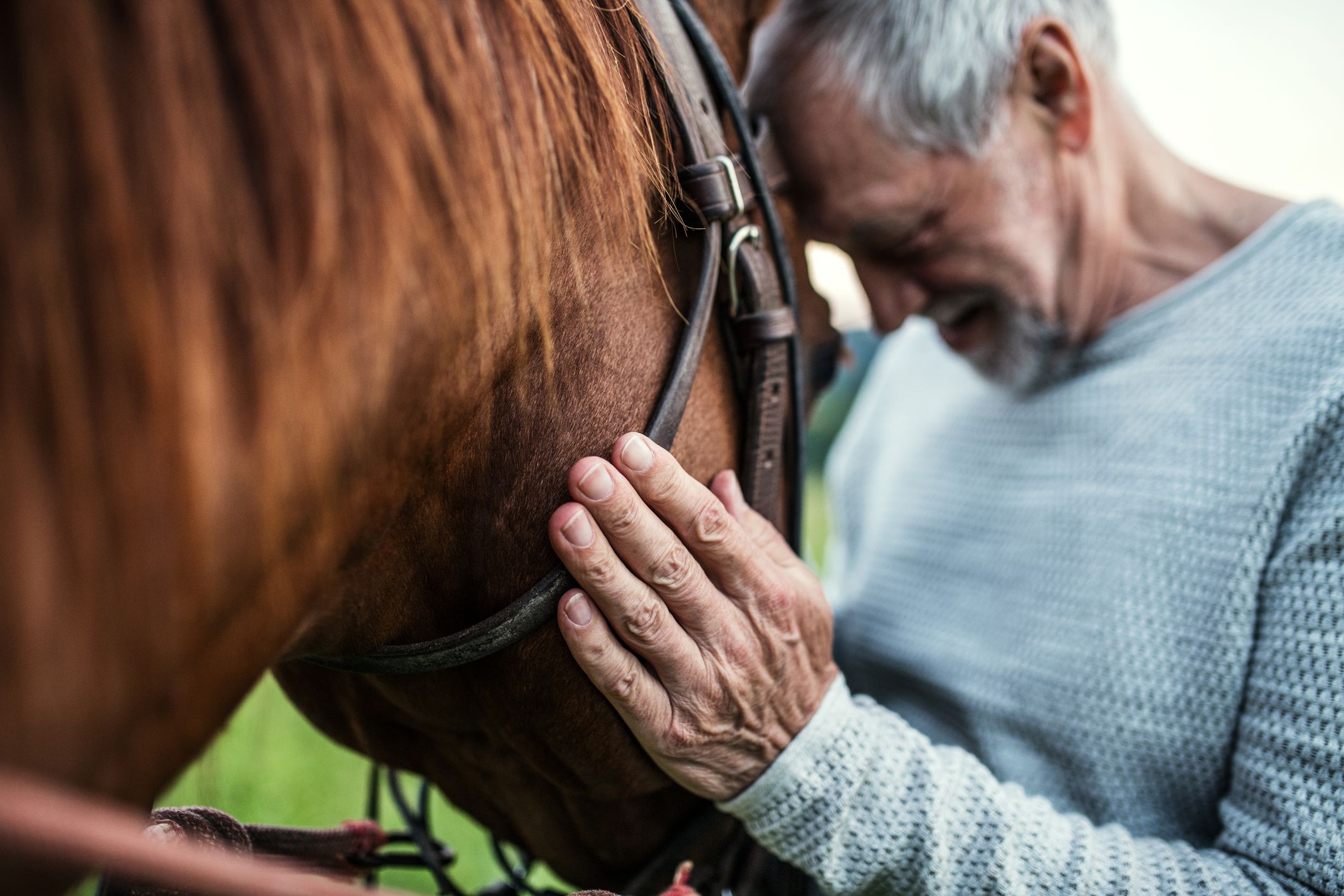
CONNECTING GOOD PEOPLE TO GOOD HORSES
Connecting Good People to Good Horses
Marketing is the process or technique of promoting, selling and distributing a product or service. Traditionally, marketing has not been the first priority for most adoption organizations. And rightfully so; the care of the horse is the first and most important focus. However, before a horse can be adopted into a loving home, the right person needs to be aware that the horse exists and is available for rehoming.
The Right Horse Initiative team attended an event last month where we had the opportunity to talk to an Arabian enthusiast who had been horse shopping for the past few months. She hadn’t found the right horse on the general market and was getting frustrated with her horse search. While she was interested in the concept, she expressed doubts that she could find the specific horse she desired through adoption. A passerby overheard this part of our conversation and interjected that she had previously felt the same way but had found a Halflinger mare at the first adoption organization she visited. Her testimony inspired other families at our booth to visit MyRightHorse.org and start their own quest to adopt.
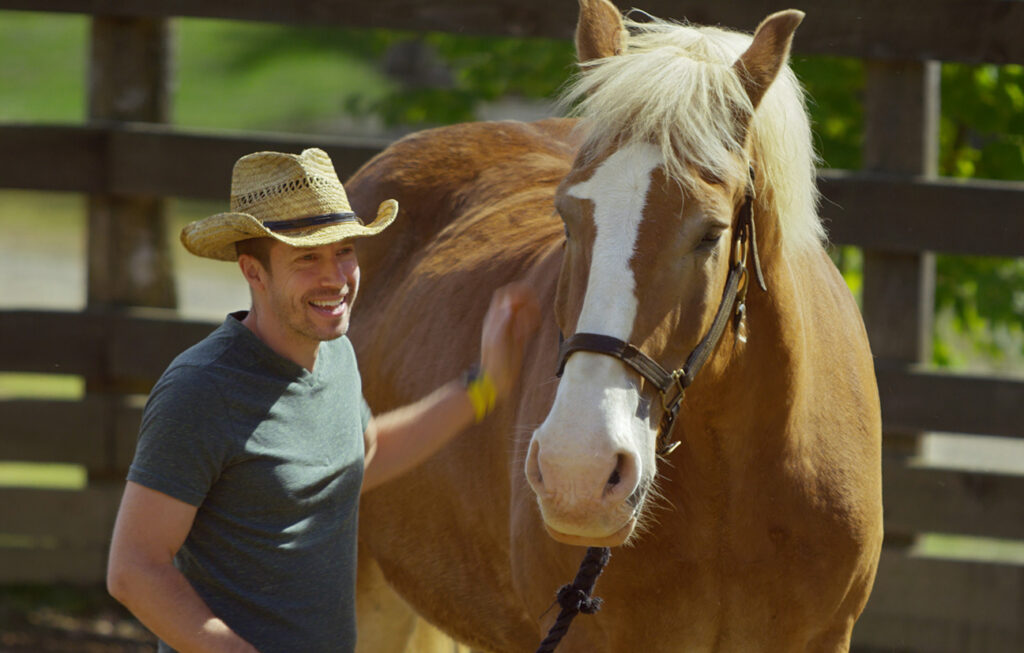
What if this type of conversation was the norm instead of the exception? The American Horse Council’s 2017 Economic Impact Study estimates that there are 7.1 million people in the United States owning or working with horses. What if we could make the 7.1 million horse people aware that adoption is another great option when looking to acquire a horse?
That is exactly what we are trying to do alongside our partners at The Right Horse Initiative. Our goal is to massively increase horse adoption; and a big piece of achieving that goal is increasing the demand for adoptable horses. Through innovative programming and a targeted effort to bring awareness into new communities, we can make a significant impact on horses in transition. We need to evaluate and elevate our existing marketing practices.
Our media partners, Horse Illustrated and Western Horseman, have been instrumental in getting the word out about adoption to new audiences. Horse Illustrated is currently running an adoption drive that has adoption-centric content on both their digital channels and print publications. Western Horseman has joined us in collecting Western All-Star Adoption Stories to promote successful adoptions of horses competing in the Western disciplines. Additionally, we are running an ad campaign in both magazines to promote adoption.
As we work to reach new segments of the horse industry and promote the general idea of adoption, more and more people are starting to become aware that adoption is a good option. Now that adoption is a concept on more people’s radar, the next step is connecting them to organizations in their area and make the adoption process engaging and accessible.
Searching for horses, whether via sale or adoption, has historically been a frustrating effort due to poorly created ads, lack of transparency and a multitude of other factors. To address the general inconsistencies we have seen in marketing horses, we have developed a new web app called My Right Horse. My Right Horse streamlines the search for adoptable horses by listing hundreds of adoptable horses in one place. Users can browse horses much like they would on any other horse sale site; by breed, age, discipline or location. The app takes a user-centric approach to make adoption an approachable, familiar and friendly option. In just the first few months since the initial launch, My Right Horse has proved that there are thousands of potential adopters curious about adoption with over 100,000 monthly page views. Now that we are gaining the public’s attention, we need to be ready with professionally presented horses and listings.
The manner in which we present an adoptable horse is an important piece of attracting the right adopter. Collectively, we need to highlight the skills and abilities of each adoptable horse and pair them with attractive, and high quality photos. Language should be positive and well edited. For example, consider the difference in these two sentences: “20-year-old gelding requires a companion-only home only due to a past injury” or “An older gentleman, Pepper has exceptional ground manners and has a lot to offer in a home where he could teach children and novices about how to handle horses.”. The second statement focuses on the horse’s abilities in a positive and engaging way.
As adoption gains more national attention and becomes a more common piece of the horse person’s vernacular and understanding, it will become even more important to represent adoptable horses in a professional manner. The demand and interest in adoptable horses is increasing and marketing is the key piece that connects the perfect home with the right horse.
Over the next few months we will be exploring different methods of marketing that have been successful in increasing quality horse adoptions. Marketing is the center point of creating change for horses in transition. It is the way we present our horses, our organizations and the way we engage potential adopters. Ultimately, marketing is the way we help horses in transition find their new loving homes.
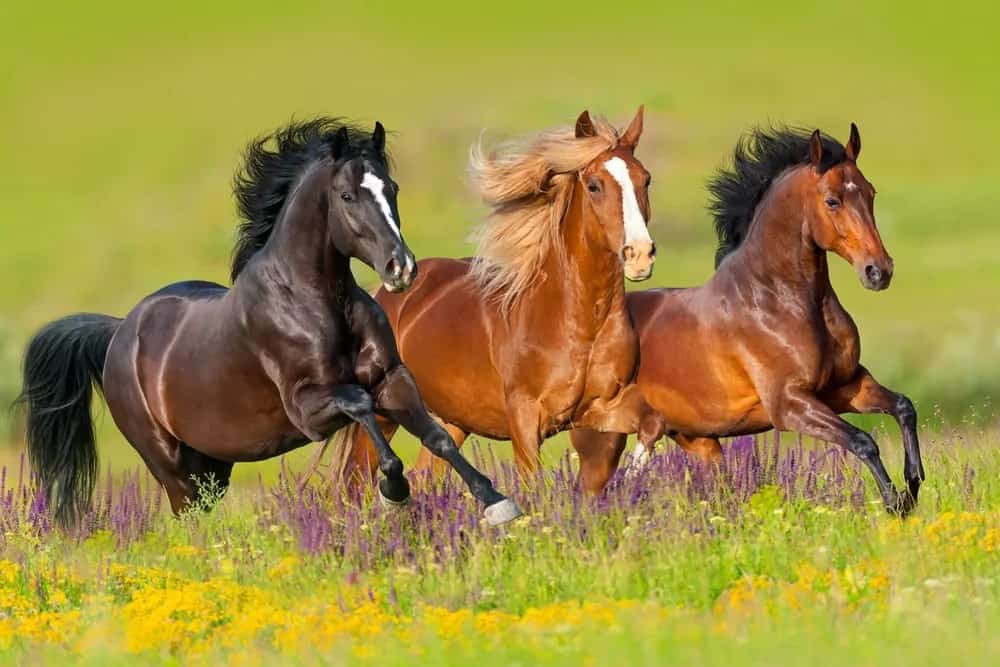
THE MYTH OF THE UNADOPTABLE HORSE
In today’s equine rescue world there seems to be a widely accepted belief that a large number of horses currently living in rescue groups or sanctuaries are unadoptable. Often these horses live the rest of their lives on the property and on the dime of the non-profit and their donor base. In theory this sounds like a lovely story, but is it really the most impactful way we can help at-risk horses? The extended length of stay of an “unadoptable” horse takes up a space that could have saved the lives of countless “adoptable” horses had they had a safe place to land. By adopting out a sanctuary horse, you are giving that particular horse the chance to be loved and cared for by a new owner while simultaneously opening the door to countless other horses needing help and care. So does it really make sense to support one at-risk horse for multiple years with the same donor dollars that could have placed dozens in new homes in that same time frame? Instead, why don’t we consider examining why these horses were labeled “unadoptable” in the first place?
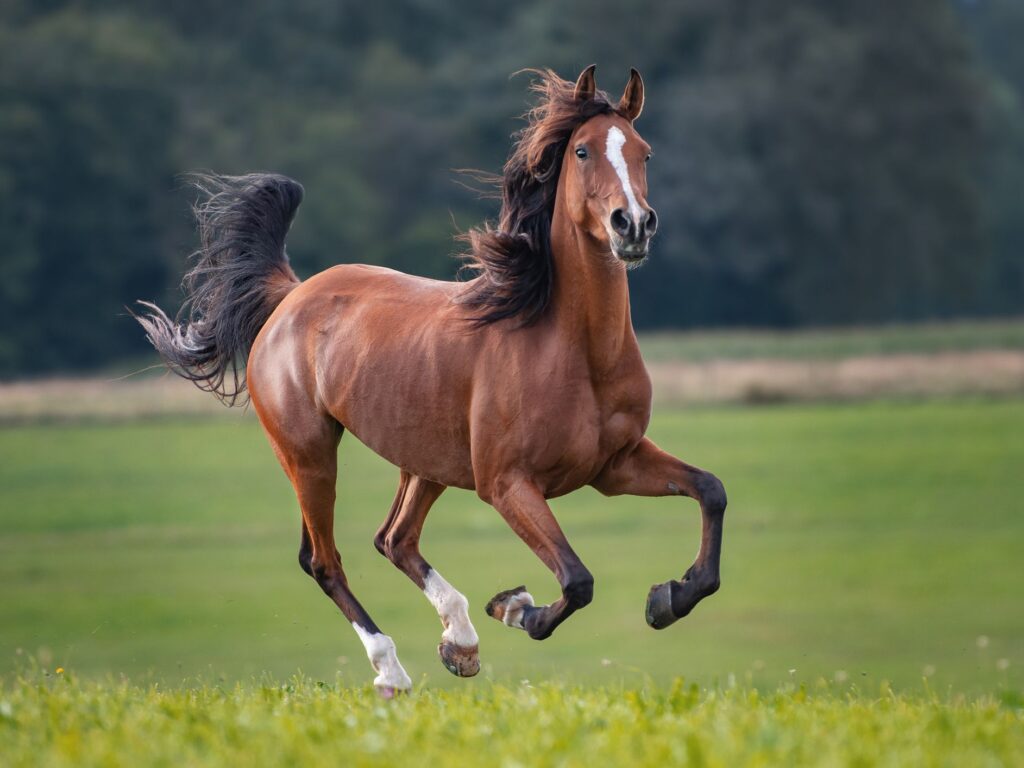
Common reasons for a horse being deemed unadoptable range from lameness issues, health problems, temperament problems or they are just plain old. Rescue groups/adoption agencies often give them the use of a paddock, lifelong healthcare and feed for as long as these horses will live. But, is it really necessary? If a horse is capable of living a quality life at a sanctuary, then why would it not be capable of doing the same in a private home? In fact, wouldn’t it be better for a horse with more advanced needs to be loved by a family in an adoptive home where it can receive individual attention?
First, let’s examine what an adoptable horse looks like. The definition of adoptable is a horse that is suitable or eligible for adoption. Generally, a horse is considered suitable for adoption if it has relatively safe ground manners (not dangerous to humans), and is healthy enough to live without suffering. These two factors are what delineates an adoptable horse vs. unadoptable. Is the horse likely to hurt someone on the ground and training efforts have failed to eliminate dangerous behavior? Is the horse going to suffer? The truth is, if either of these things are true about the horse, then the horse becomes a euthanasia candidate.
Veterinarians must always be involved in the euthanasia conversation. The American Association of Equine Practitioners has publicly posted widely accepted criteria for euthanasia to help guide equine veterinarians when making a euthanasia decision. The decision comes down to unmanageable pain and suffering. If a horse is so unhealthy that it is experiences ongoing suffering then it should not be in a sanctuary. Rather, the horse should be granted a humane ending. The decision whether and when to euthanize should always be made under the guidance of an equine veterinarian.
The good news is most sanctuaries in the United States are not filled with horses that are dangerous to people or live in a state of unmanageable suffering. In fact, most horses in organizations that are labeled unadoptable are simply old, not trained, have some manageable health issues or not able to be ridden.
Let’s go ahead and dispel some of the myths surrounding the mislabeled “unadoptable” horses. The untrained horses simply need some training to become adoption candidates. Old horses are not easy to adopt but they can be adopted, and therefore should be adoptable. What about the horses that have some health issues that make them ineligible for riding? Sometimes equine advocates can feel like an adopter couldn’t take care of a horse’s special needs. In fact, often these assumptions are wrong. There are adoption groups that have experienced great success placing special needs horses and companion horses. I’m not saying it is easy; but with creative marketing and a positive adoption philosophy it can definitely be done. There are adopters out there that are capable and willing to take on special needs horses. There are even some who enjoy providing extra care and feel fulfilled by providing a great home to a horse in need. Check out two ASPCA Pro webinars for great ideas and tips here and here.
In addition to benefiting individual horses, shifting to find homes for previously-deemed “unadoptable” horses opens up a whole new world for organizations. Let’s take a look at a rescue called Horses’ Haven. This fantastic adoption group in Howell, Michigan was established in 1995. This group truly identified itself as a sanctuary since inception. In 2015, they had approximately 70 horses in their care; 50 were considered sanctuary horses. They did under five adoptions a year and their 70-capacity barn was completely filled with “unadoptable” sanctuary horses. Then, something changed. They no longer wanted to say no to all the requests to help horses; but they were forced to say no as they had no space. In 2016, they decided to develop a strategy to move the sanctuary horses out of their rescue so they could begin to say yes again. Flash forward to one year later and they increased their adoptions to 36 horses! Each and every one of those horses adopted was originally considered unadoptable. How did they do it? They focused on training the horses and seeking out adopters that would tolerate some special needs. The board of directors no longer believed in the notion that sanctuary was the best place for the horses. They began to understand that if they placed these horses they could exponentially increase the number of horses they were able to help each year. The sanctuary became a legitimate and strong adoption program.
Another organization that is helping to dispel the myth of the unadoptable horse is the New Mexico Horse Rescue. In June of 2019, they placed a horse named Strawberry into a new home. What was special about Strawberry was she had been at their barn for eight years. She was a shy and introverted horse considered virtually unadoptable. However, with an increased effort by volunteers and staff to socialize and train her, suddenly her future was very bright. She even gained enough confidence to become a lesson horse in her adoptive home. Strawberry was not the only one. New Mexico Horse Rescue made a concerted effort to focus on their long timers and guess what…they placed many of them! It simply took their staff and volunteers deciding that these horses were valuable and adoptable.
Now what if half of the current sanctuaries in the U.S. did something similar in their programs? What if they decided to get creative, train the untrained, find the companion homes, change their own perspective? I’ll tell you what would happen; we would have the twice the capacity in this country to assist at-risk horses. We could help twice as many horses. In a world where adoption is one of the last considered options for acquiring a horse, don’t we need to be promoting the adoptability of ALL of our horses? If we ourselves are claiming that so many of our horse in care are unadoptable or sanctuary horses, aren’t we just re-affirming the public’s belief that we aren’t the place to go to get a horse? Instead, let’s take a long hard look at the horses in our care and really consider if they indeed are adoptable. Once we look at our own horses as adoptable, it is much easier to convince the public they should adopt them.

4 surprising activities to enjoy in Beau Vallon’s only beach-front hotel
Everyone who has visited the Seychelles even once knows the Beau Vallon beach on the north-western coast of Mahé. It’s a gorgeous ribbon of white soft sand set against a pretty floral backdrop. Plus it is famous for its superb diving opportunities.

It’s a well protected area and government has banned building along the hemline, save for one solitary hotel that has been built directly on the beach: the Coral Strand Smart Choice Hotel. For beach lovers this is an idyllic venue and the only one that has easy access to diving, snorkelling and of course sunbathing.
With it’s amazing location staying here is a no-brainer. But be sure to enjoy these surprising activities:
Try a cooking masterclass
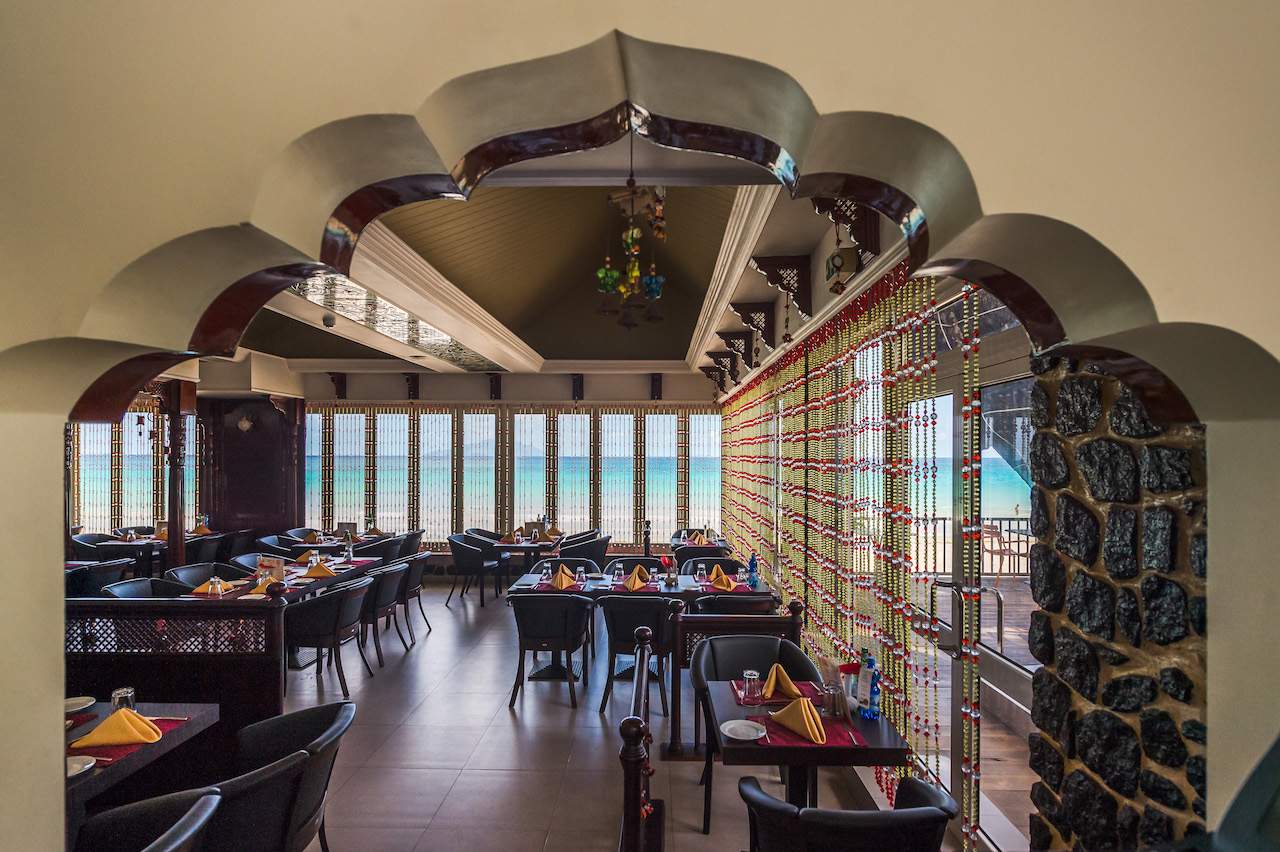
Restaurant “Mahek” at the Coral Strand
The Coral Strand has one of the best authentic Indian and oriental restaurants in the Seychelles called “Mahek”. You can watch as chefs from India and South-Eastern Asia create their dishes. Or join one of the cooking masterclasses held regularly at the hotel.
The “Coral Asia” restaurant is located on the upper terrace of the Coral Strand where you can dine to a backdrop of gorgeous ocean views that are particularly dramatic during sunset.
Experience the traditional “Moutya” dance at sunset

Get into the spirit and join a “Moutya”. This is the traditional dance of Seychellois that takes place on the beach.
It starts long before sunset by finding enough palm leaves for a bonfire. Once lit, dancers perform a local dance around it. When the fire is at its zenith the men begin to beat their drums increasing the rhythm and power while the women respond by singing and dancing around the fire. As the energy embraces the participants they are led into a trance-like state. It’s hard to resist joining in.
Spend an evening stargazing from the island’s only astronomical observatory

Experience the enthralling beauty of the Seychelles sky at night from the only astronomical observatory on the island. It is located on the roof top of the Coral Strand and you can gaze at the stars and appreciate how they twinkle so brightly thanks to the lack of pollution.
Take an invigorating hike on the island

Anse Major
Mahé has some wonderful hiking opportunities including a two-hour trail that begins not far from the Coral Strand. Follow the trail through dense tropical forest and open stone plateaus to the small and cosy Anse Major beach.
We recommend taking snorkelling gear as Anse Major is great place to enjoy the world under water. Fish swim close to the shore and so it’s ideal for young families to take the plunge.
The hotel can organise hiking trips to Anse Major and several other trails where you can experience the indigenous nature of the Seychelles.
Tip: Make sure you bring plenty of water, suncream and to wear appropriate shoes as some parts of the paths are steep and rocky.
More about Coral Strand Smart Choice Hotel
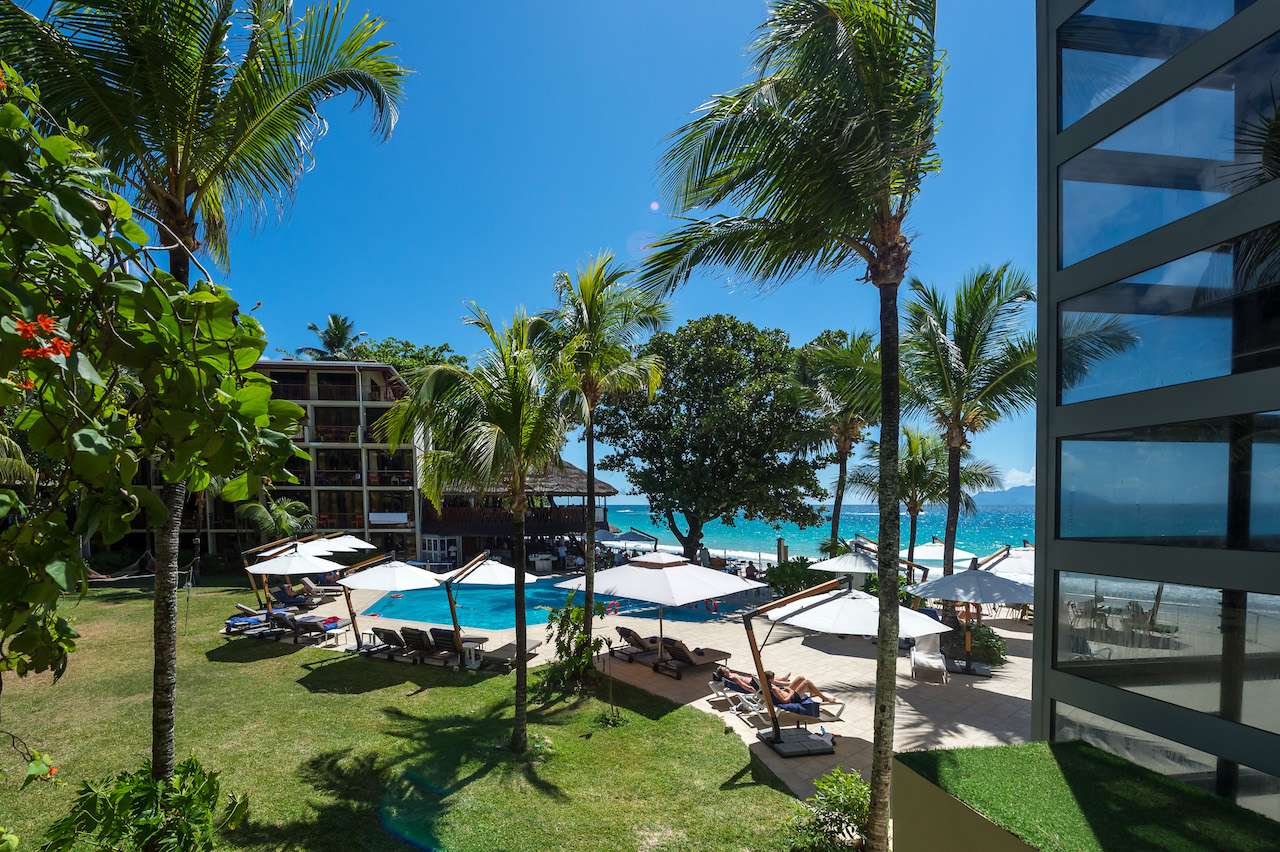
Coral Strand Smart Choice Hotel in Beau Vallon, Seychelles
Coral Strand is the only hotel in Seychelles located right on the beach. Just step out onto the Ocean Deck Bar, walk five metres and you are greeted by the calm waters of the Indian Ocean. The shutter windows of the Island Trader restaurant open directly onto the beach and sea which means you can take a dip while waiting for your order to arrive.
The Coral Strand can also organises classes that include basket weaving classes, making hats out of palm leaves, and how to break a coconut.
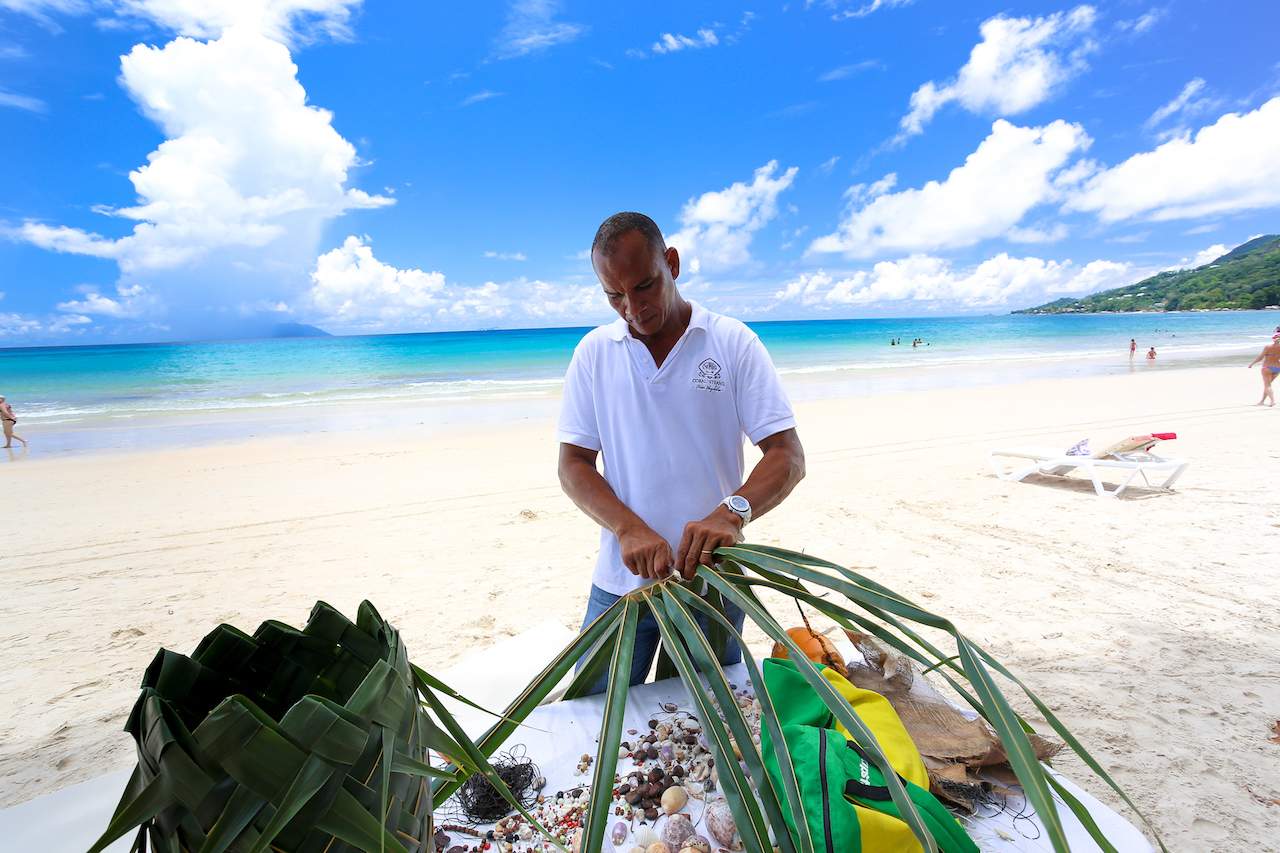

Deep South USA Music Triangle – Nashville, Tupelo and Memphis
A new direct flight linking London and Nashville is an opportunity to soak up the atmosphere of three music cities. Nashville is country music, Tupelo is the birthplace of Elvis and Memphis has soul.

You’ll need to hire a car, turn on the stereo and enjoy the drive. From Nashville, Tupelo is around four hours, then Memphis is another two hours.
If you’re feeling more adventurous then follow the Mississippi River south, exploring the land where the blues began.
Nashville, Tennessee
Music City USA is still the capital of country music and bars and honky-tonks line downtown Broadway. There’s good music in the clubs and at the famous Grand Ole Opry. Elvis appeared on stage here early in his career and made many of his famous recordings at RCA studios.
Ryman Auditorium
Celebrating its 125th anniversary in 2017, the Ryman Auditorium was originally a church and its seats are still as hard as any pews. It was the home of the Grand Ole Opry from 1925 until 1974 when it moved to a new venue on the outskirts of town. These days there are still concerts most nights and, in winter, the Opry moves back to its former home and broadcasts live.
The Station Inn

The Station Inn
For more than 40 years, The Station Inn has presented great bluegrass, roots and Americana music. It’s a small unassuming venue in the heart of Nashville, an area known as the Gulch. Many of the world’s most successful musicians have played at here, including Bill Monroe, Vince Gill, Alison Krauss and John Prine. What’s great is that it sells beer and pizza at pub prices and the admission prices are low.
Country Music Hall of Fame and Museum
Elvis, of course, is featured in the Country Music Hall of Fame and Museum and they’ve even got one of his gold plated Cadillacs. However he takes a back seat to this unrivalled collection of country music artefacts, recordings, photographs and videos, spreading over two floors. And it’s not all country – the most recent exhibition is dedicated to Bob Dylan, Johnny Cash and the Nashville Cats.
Studio B
After RCA bought his contract from Sun, Elvis started making money for the company and they built these studios in 1957, in part so he could record here. More than 35,000 songs were brought to life at Studio B, including over 260 Elvis recordings, 40 million selling singles, and more than 1,000 American hits – songs like Roy Orbison’s “Only the Lonely,” the Everly Brothers’ “Dream,” Dolly Parton’s “Jolene” and Elvis’s “Are You Lonesome Tonight?” A guided tour takes you round the studios, tells the story behind many of their greatest hits and you can even sit at the famous Elvis piano.
Tupelo, Mississippi
Elvis Aaron Presley was born in Tupelo, Mississippi, on January 8, 1935, to Vernon and Gladys Presley in a wooden two room shack, built by his father, grandfather and uncle. They moved out when he was only a few years old but, in 1957, he donated the proceeds of a concert to the city so they could create a park here.
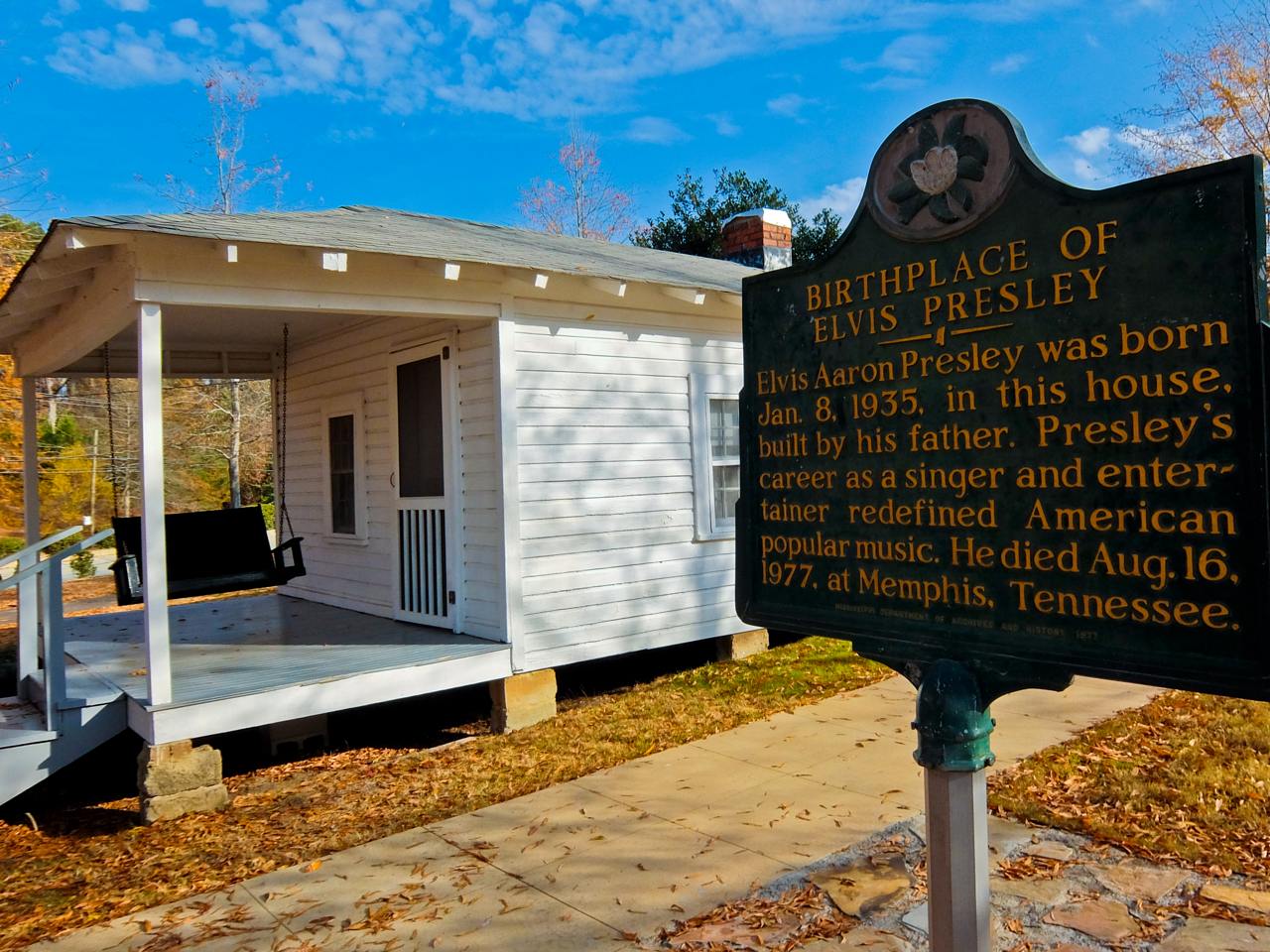
Elvis Birthplace
They purchased 15 acres, including the house and renamed the road around it Elvis Presley Drive. Of course the original furniture was long gone, but from 1971, the East Heights Garden Club made it their business to duplicate the house’s contents. You can now see how it might have been when the Presleys lived here in the thirties in the Elvis Presley Birthplace
Although the house now sits in green parkland, there used to be other houses nearby. In 2008, the Assembly of God Pentecostal wooden framed church was moved here from a block away. In this building, Elvis was first exposed to the rich Southern gospel that became a staple of his musical repertoire. Today, there are no live services, but instead a 15 minute multimedia recreation of a Pentecostal service from the 1940s.
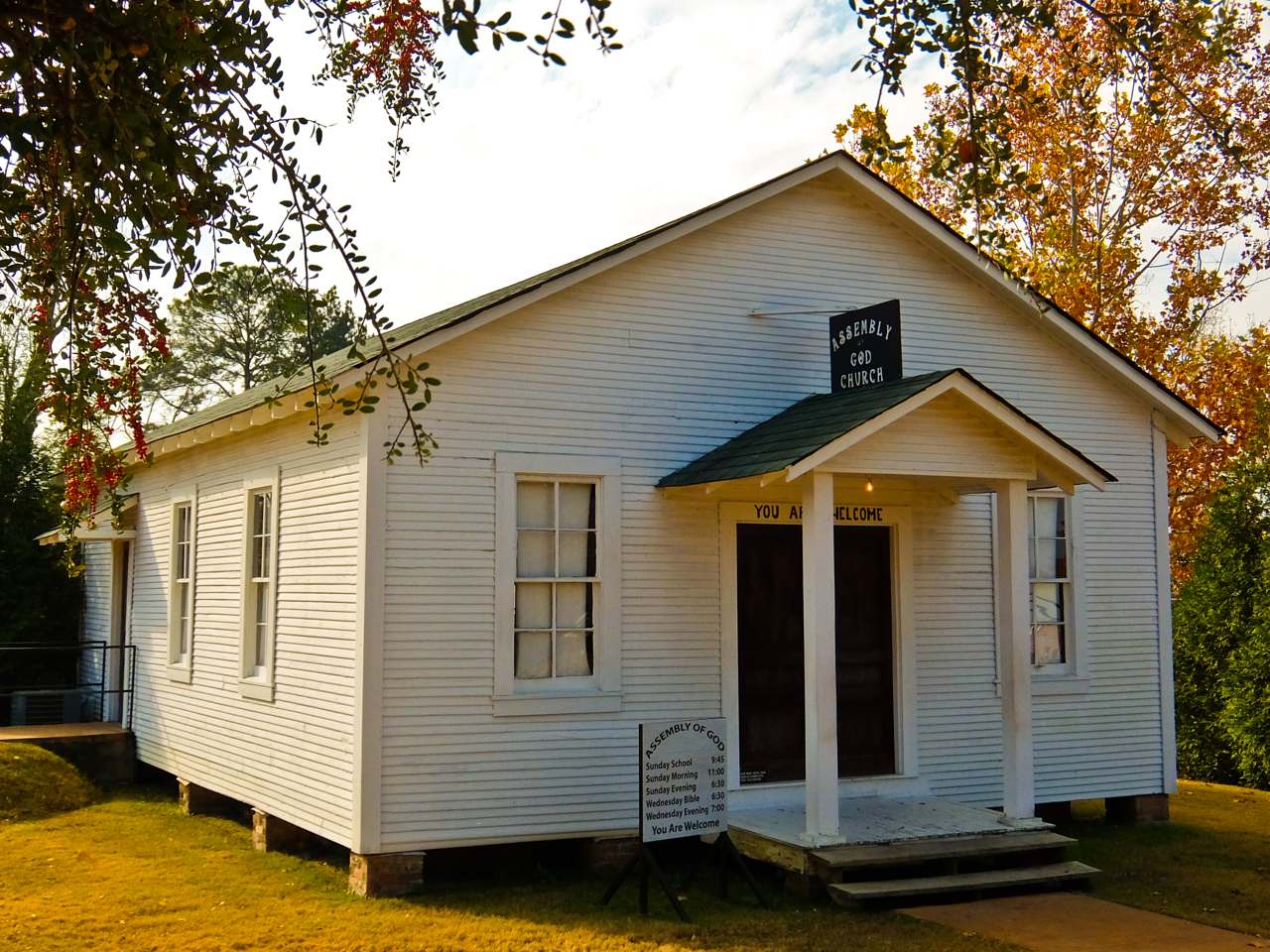
Elvis Church
There’s also a small museum displaying the collection of Janelle McComb, a Tupelo resident and friend of the Presley family. Highlights include examples of Elvis’s splendid dress sense – corduroy suits, an orange-striped parka, and fishnet and paisley shirts with puffed sleeves. A huge diorama shows the neighbourhood as it appeared during Elvis’s boyhood.
Memphis, Tennessee
After being the undisputed capitol of soul music, Memphis went into depression after the assignation of Martin Luther King Jr. at the Lorraine Motel here in 1968. These days it’s undergoing something of a revival, with funky clubs on Beale Street providing non-stop live music, and a new Stax museum and Academy. Even Graceland, Elvis’s home for most of his working life, is expanding.
Sun Studio

Sun Studio
Sam Philips founded this tiny studio in an unassuming brick building in 1950, little knowing it would become the birthplace of rock and roll. Elvis paid to record his first tracks here in 1953, but Sam Philips called him back in 1954. The result was his first hit “That’s Alright (Mama)”, and there were five more over the next fifteen months. You can almost feel the star magic as Jerry Lee Lewis, B.B. King, and many others recorded here. It’s still a functioning studio, although in use only at night, as hordes of fans pass through during the day.
Arcade Restaurant
A couple of miles away is the Arcade Restaurant, one of Elvis’ favourite haunts, and still growing strong. They’ve preserved his booth at the rear, where he would slip in unnoticed and sit with his back to the other diners. You can even order one of his favourites – a deep fried peanut butter and banana sandwich, although you might want to pass on the added bacon.
Graceland

Graceland (c) Rupert Parker
Thirty minutes from downtown is Graceland, the house that Elvis bought in March 1957 and occupied until he died. It’s a surprisingly unassuming property and even the furnishings, bearing in mind the excruciating bad taste of 70’s, are not too ghastly. Of course it’s been kept exactly as he left it, and you can see his parent’s bedroom, the kitchen, jungle room and basement den, although upstairs is out of bounds. Apparently his daughter, Lisa Marie, still makes use of it during festive occasions. Elvis is buried next to his parents outside, at the foot of the swimming pool.
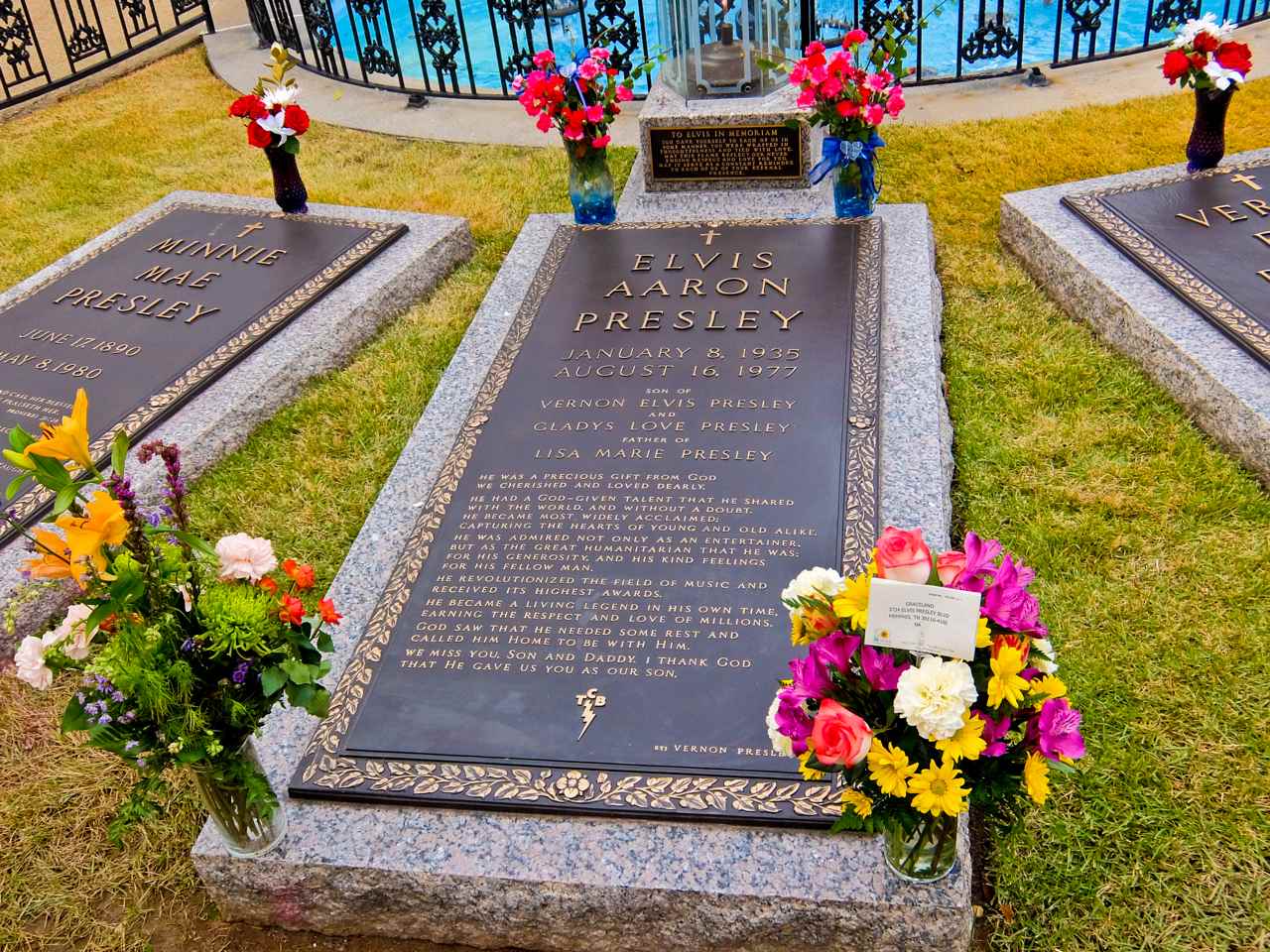
Elvis Grave
Recently the land on the other side of the road has been transformed into a sprawling entertainment, retail, dining and exhibition complex, now named Elvis Presley’s Memphis. The highlight is the museum celebrating his music, movie and concerts, with hundreds of artefacts including a collection of suspiciously small jumpsuits. In an adjacent building Presley Motors contains over 20 of his cars, including the iconic 1956 Pink Cadillac Eldorado, plus golf buggies, go carts and even a lawn mower. In a separate area sit two of his private jets and you can climb aboard the Convair 880, which has Lisa Marie’s name painted on the fuselage.
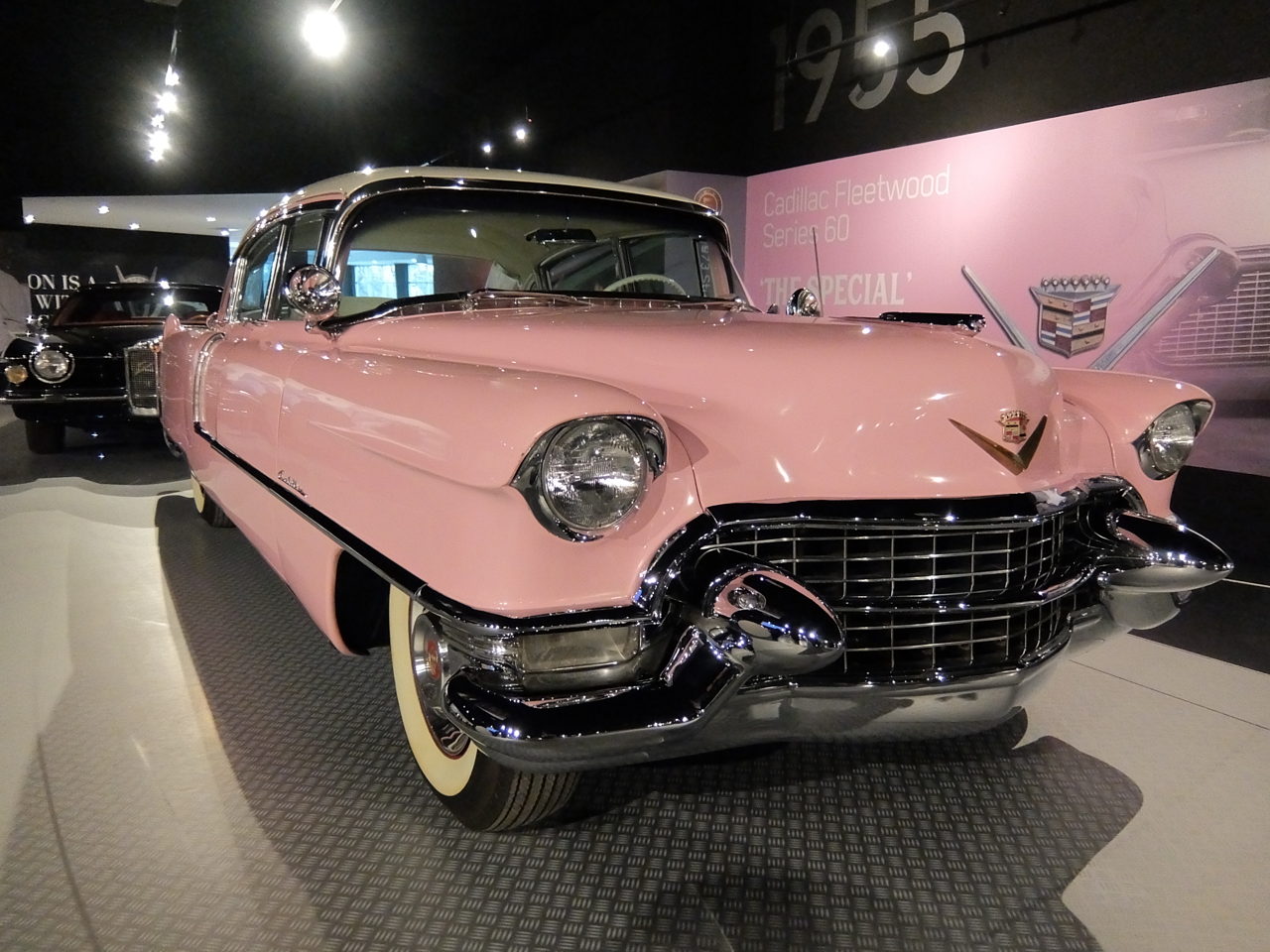
Elvis Pink Cadillac
Elvis loved home cooking so there are two themed restaurants named after his parents, Gladys and Vernon. Gladys’ Diner features classic American fare, including that famous Elvis sandwich and Vernon’s Smokehouse serves authentic Memphis BBQ, smoked in-house. Of course, if you’re after Elvis merchandise you’ll find the world’s largest collection on sale in the various gift shops.
Smithsonian’s Rock ‘n’ Soul Museum
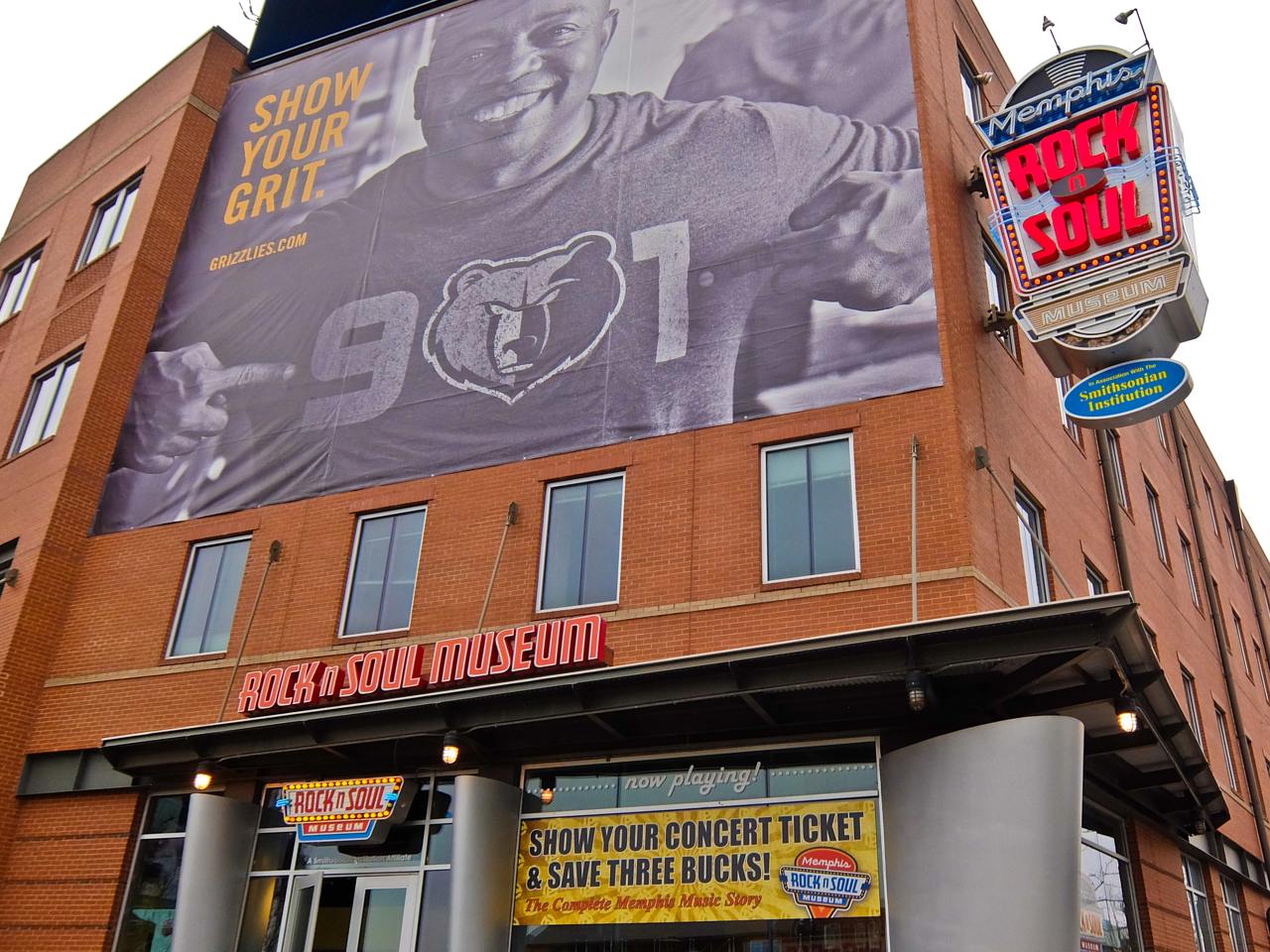
Rock and Soul Museum
Memphis, of course, isn’t just about Elvis and the Smithsonian’s Rock ‘n’ Soul Museum brings its impeccable eye to the story of the three important revolutions in music that happened here. It takes you from the birth of the blues in the ‘20s, rock and roll in the ‘50s and soul music in the ‘60s.
Stax Museum of American Soul Music

Stax Museum
In another part of town, Stax Studios has risen from the dead and is now the Stax Music Museum of American Soul Music. It includes a recreated studio plus artefacts from the time and a well laid out display telling the history. Next door there’s the Stax Music Academy which nurtures young black talent and stages occasion concerts.






